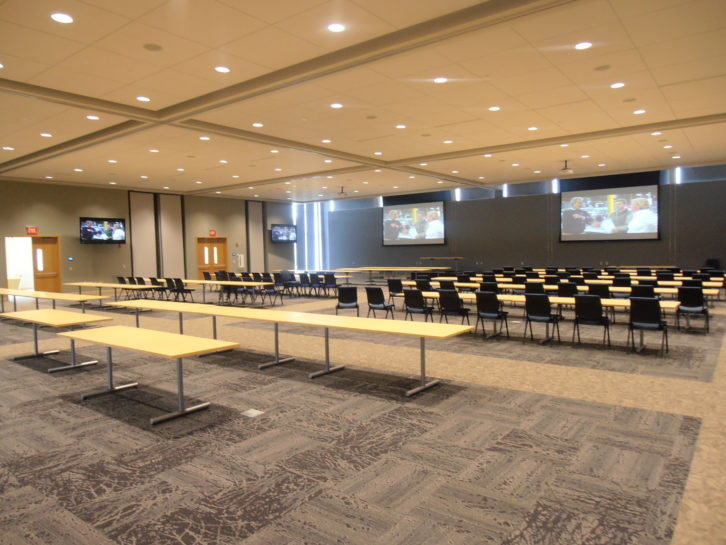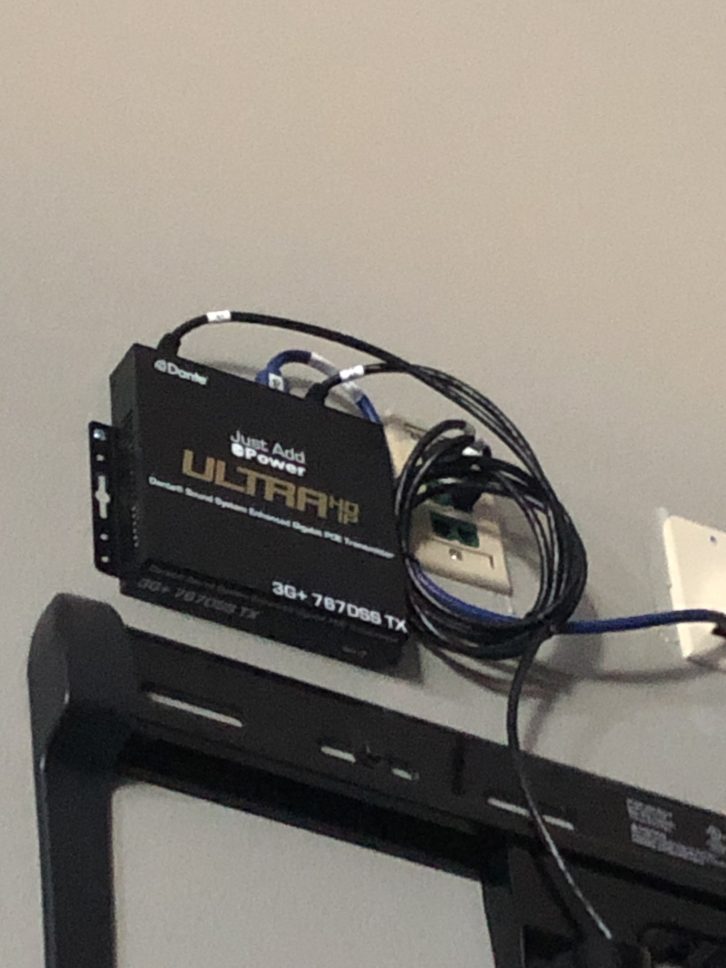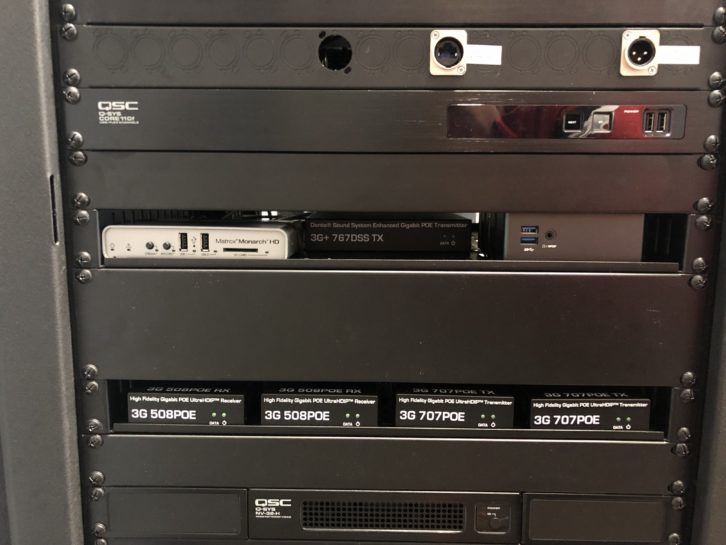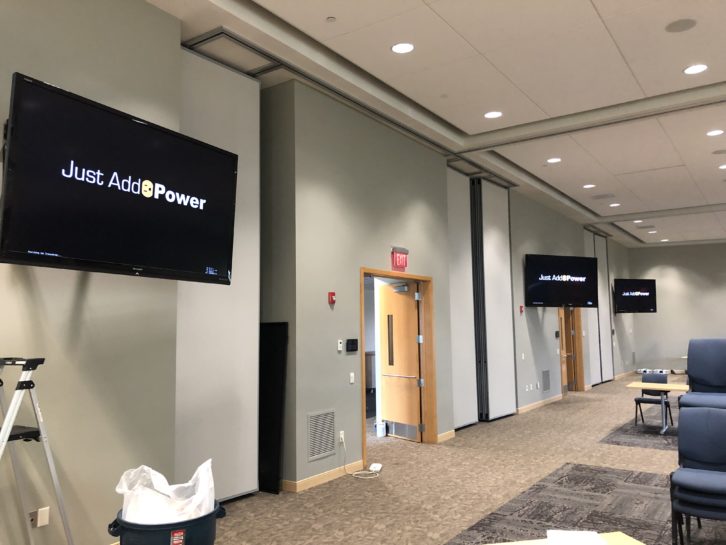
When a leading discount retailer in the Madison, Wisconsin area decided to upgrade their headquarters conference center they called in Audio Contractors to make the changes using Just Add Power’s Ultra HD over IP platform. Andrew Szlapka has the story for us.
SVC: This is a very timely subject. We’ve been doing a lot of videoconferencing stories lately since everybody is trying to stay safe. Lots of businesses are trying to retrofit videoconferencing or upgrade their existing systems. Before we get into installation specifics, tell us about your outfit, Audio Contractors.
Andrew Szlapka: Oh, sure. We’re located right outside of Madison, Wisconsin; we were established in 1998. We have about 22 employees and we just continue to grow every year. We’ve steadily grown into about 50 percent commercial and 50 percent residential. My role within the company is strictly commercial and I’ve been with Audio Contractors for a little over four years now.
Your client on this one was Blain’s Farm & Fleet. They’ve had phenomenal growth so give us a little background on them.
Well they are a discount retailer. They typically sell farm, camping, and hunting supplies but they also sell tires, automotive services. They’re right up there with the Walmarts and companies like that. They started in 1955 and the first store was only 1,000 square feet and located in Janesville, Wisconsin. It’s a major reason why their headquarters is now located in Janesville where the project took place. Now they have grown to four states within the Midwest.
It sounds like that growth brought some challenges in communication, specifically in their conference center. What did they have there and how did they want to improve it?
They have one large space that can be divided into six smaller spaces. They hold a lot of vendor shows where partner companies come in and display their products, whether that’s camping supplies or a new clothing line or feed for livestock. This project was actually in the works for a little over a year; we were working with the IT staff on getting the budget put together and the correct system built. I met with quite a few people from Blain’s Farm & Fleet and figured out their needs and wants, I specified a system, and we put it into the budget. We went up against a few other competitors and we were the ultimate winners. They were initially going to put the project on hold and then the pandemic came. At that point, they really saw a stronger need for it.
Yeah, I’ll bet when the pandemic hit, they wished that they had done this sooner.
You bet, yeah. [Laughs] So we kind of expanded on it and tailored it more when we started to deploy the final parts of the system.
So they wanted more versatility with the system and it appears they had some serious reliability issues as well.
Definitely. The system that was originally put in there allowed them to control TVs and the projectors and switch video. However, it wasn’t that easy to use. When it came to live sound, mixing microphones, and getting in the correct gain before feedback and acoustic echo cancellation for video conferencing, it just would not support that.
And in terms of the video they were also running into kind of a dead end trying to distribute a lot of HDMI signals.
Yeah. They were running a rather large HDBaseT setup and they had HDBaseT distribution amplifiers so it was limited inputs to a whole bunch of outputs. Very cumbersome to use and if one of those distribution amplifiers went out it caused a large problem for them. They weren’t able to just switch over to another input. They could be down for the whole day or until a technician got out there to replace it.
What was the first thing you had to do when you got into the facility? You obviously had to get some fairly detailed information from the client first.
Yeah. I met with many of the people that use the system on a daily basis. I had them show me how they use the system, how they interact with it. And from there I asked them what they would like in the new system and took all their answers and put them together, slimmed down some of the stuff that would have caused the system to be hard to use, and allocated it a different way. We wanted to keep the systems easy to use with the most flexibility.
That’s always the big trick–the more flexibility, the more challenging it may be to operate. That’s where all of the creativity in the system design really comes in.
And I used a lot of creativity in this one. [Laughs]
 I think one of the things you did was to put users into two user categories with one of them having higher authorization to make more detailed system adjustments.
I think one of the things you did was to put users into two user categories with one of them having higher authorization to make more detailed system adjustments.
That’s one of the really exciting things about this system. We used QSC’s Q-SYS for the control platform. If you’re familiar with Q-SYS it’s very simple to use, very efficient to deploy, and we created a couple of different user interfaces—one very simple and one more advanced. When this large room is split up into the six individual rooms, a user can walk in there and be presented with the touch panel that says ‘Welcome to Area D’ and ‘Push Here to Get Started’. You push as instructed, the TV turns on, the volume is set at a certain level predetermined by us during commissioning, and it tells you which two wireless microphones are available for that room. That’s it.
You touched earlier on how they combine multiple rooms for a larger event. There’s a touch panel in each room and you have the dual authorization levels for the users.
In that case, the user goes to one of the touch panels and it will say, For more advanced options select here. The user has to enter in a four-digit code that opens up a full set of full video matrixing, assigning microphones to rooms. They use one of the TVs as a countdown timer for the speaker that’s up on stage. It’s specifically tailored for that. Some of the commands are presets that automatically setup the room, or they can make adjustments as needed. That page also opens up the video conferencing to control the camera that’s mounted in the ceiling, which is another QSC PTZ camera. You can quickly select presets for that camera or change it on the fly as needed.
I understand they already had a fair amount of CAT6 wiring installed in the place.
Yes. It was a huge benefit. When they were building this conference center maybe seven or eight years ago, the IT director had them install six CAT6 at each TV location. So I traced down the wiring and found we just needed to punch down three more at each TV and all our wiring would be set.
You had a number of ways to execute the signal distribution; why did you decide to go with the Just Add Power Ultra HD over IP platform?
We focused our energy in a different direction during the early phases of the design, but then I ran into a few technical roadblocks. Just Add Power offered an easy-to-integrate solution that not only solved our technical issues, but actually made the project a little more cost-effective. One of the major benefits that Just Add Power offered the system was the ability to take audio off the HDMI wall plate input and onboard it into the DSP AES67; we used their 767DSS encoder for that.
I think the original situation was they could only send the signal within that particular room.
Correct. Yeah. The original HDMI wall plate ran directly up the wall and plugged into the TV; that’s how you used the system. So if I used Rooms C and D and I needed combine those together I couldn’t. The only way you could combine all the rooms is by using the main input at the equipment rack that had the distribution amplifier on it. That went out to all the TVs. But now, with the new system, if I’ve got two rooms across from each other that I would like to utilize, especially for social distancing now, I can spread all these folks out and have all displays running, the audio perfectly in sync in both rooms, and control both rooms from one interface.
How many receivers did you use on this project?
One for each TV, which would make six. One for each projector, two. And then we fed one into the QSC NV-32-H for videoconferencing and then we fed one into the Matrox Monarch HD for simple recording and streaming live to their soon-to-be YouTube channel.
That Matrox Monarch HD is so easy to use in recording, so this system gets them beyond the walls of the building and out into the real world when the situation calls for it.
 Yes. With Blain’s Farm & Fleet serving a lot of the rural areas, some of their facilities are in areas where maybe they’re not getting great Internet speeds. The new system allows them to push content out to their store managers via an email or a shared drive where they could download it, put it on a USB stick, and play it in their breakroom if it’s a companywide meeting. Again, they’re trying to avoid bringing in all of these people from remote locations.
Yes. With Blain’s Farm & Fleet serving a lot of the rural areas, some of their facilities are in areas where maybe they’re not getting great Internet speeds. The new system allows them to push content out to their store managers via an email or a shared drive where they could download it, put it on a USB stick, and play it in their breakroom if it’s a companywide meeting. Again, they’re trying to avoid bringing in all of these people from remote locations.
Typically in these projects the video gets a lot of the press, but in the actual system operation the bigger challenge sometimes can be the sound, suppressing feedback, and making sure people aren’t talking over each other. So describe the in-ceiling speaker system.
You know, as our name is Audio Contractors, we are super passionate about audio. A lot of us have a large background in Pro Audio or Hi-Fi so we take pride in our audio. Inside the training center they actually had a well-built audio system already. They had eight-inch, two-way inceiling speakers and they had enough in each room for adequate coverage. The intelligibility was there, the sound quality was there, and the power was there so we decided to reuse that system. The speakers are Speakercraft and there’s an eight-channel Lab.Gruppen amplifier.
And I would assume that all of the mics in there are wireless.
Yes. They are all Shure wireless mics. They are within spec for the wireless. However, there’s talk of moving to a new Shure setup where we’re only using Dante and moving away from RF.
What kind of training sessions did you hold?
We actually held a couple of training sessions so that we didn’t cram everybody into one area. Given the complexity of the system, our technical staff provided two rounds of in-person training for a variety of Farm & Fleet staff members. So there was a round for the more technical users and then there was a round for the basics and best practices on maintenance and how to hold the microphone and how to check batteries. Simple things like that.
With this one in the books what’s coming up next for Audio Contractors?
We actually have a lot planned for next year. We have a large and very well-known hotel in the Madison area that’s going to have a large expansion, and upscale restaurant/bar that is getting a sizeable Just Add Power system, and quite a few conference rooms within the corporate market.
 We’ve been talking with Andrew Szlapka with Audio Contractors in the Madison area about the new conference center upgrades at the Blain’s Farm & Fleet headquarters. I know you enjoyed the work Andrew, and thanks for letting us know how you got it done.
We’ve been talking with Andrew Szlapka with Audio Contractors in the Madison area about the new conference center upgrades at the Blain’s Farm & Fleet headquarters. I know you enjoyed the work Andrew, and thanks for letting us know how you got it done.
Thank you for having me.









